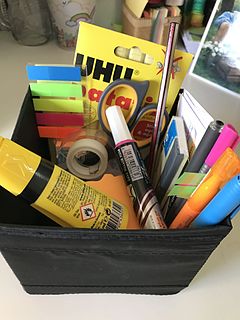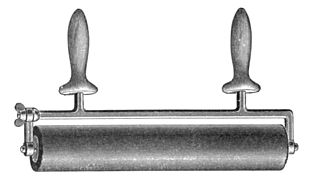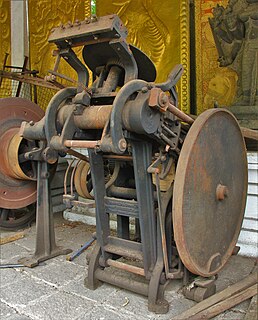
Printing is a process for mass reproducing text and images using a master form or template. The earliest non-paper products involving printing include cylinder seals and objects such as the Cyrus Cylinder and the Cylinders of Nabonidus. The earliest known form of printing as applied to paper was woodblock printing, which appeared in China before 220 AD for cloth printing. However, it would not be applied to paper until the seventh century. Later developments in printing technology include the movable type invented by Bi Sheng around 1040 AD and the printing press invented by Johannes Gutenberg in the 15th century. The technology of printing played a key role in the development of the Renaissance and the Scientific Revolution and laid the material basis for the modern knowledge-based economy and the spread of learning to the masses.

Stationery is a mass noun referring to commercially manufactured writing materials, including cut paper, envelopes, writing implements, continuous form paper, and other office supplies. Stationery includes materials to be written on by hand or by equipment such as computer printers.

The Ben Day process, named after illustrator and printer Benjamin Henry Day Jr. is a printing and photoengraving technique dating from 1879. While the Ben Day process is commonly described in terms of dots, other shapes may be used, such as parallel lines, textures, irregular effects or waved lines.

Offset printing is a common printing technique in which the inked image is transferred from a plate to a rubber blanket and then to the printing surface. When used in combination with the lithographic process, which is based on the repulsion of oil and water, the offset technique employs a flat (planographic) image carrier. Ink rollers transfer ink to the image areas of the image carrier, while a water roller applies a water-based film to the non-image areas.

A small press is a publisher with annual sales below a certain level or below a certain number of titles published. The terms "indie publisher" and "independent press" and others are sometimes used interchangeably.

Letterpress printing is a technique of relief printing. Using a printing press, the process allows many copies to be produced by repeated direct impression of an inked, raised surface against sheets or a continuous roll of paper. A worker composes and locks movable type into the "bed" or "chase" of a press, inks it, and presses paper against it to transfer the ink from the type, which creates an impression on the paper.

A wedding invitation is a letter asking the recipient to attend a wedding. It is typically written in the formal, third-person language and mailed five to eight weeks before the wedding date.
Tympan means skin, and is used in a variety of technical meanings.
A platen is a flat platform with a variety of roles in printing or manufacturing. It can be a flat metal plate pressed against a medium to cause an impression in letterpress printing. Platen may also refer to a typewriter roller which friction-feeds paper into position below the typebars or print head, it can refer to the glass surface of a copier, or it can refer to the rotating disk used to polish semiconductor wafers.

The size of a book is generally measured by the height against the width of a leaf, or sometimes the height and width of its cover. A series of terms is commonly used by libraries and publishers for the general sizes of modern books, ranging from folio, to quarto (smaller) and octavo. Historically, these terms referred to the format of the book, a technical term used by printers and bibliographers to indicate the size of a leaf in terms of the size of the original sheet. For example, a quarto historically was a book printed on sheets of paper folded in half twice, with the first fold at right angles to the second, to produce 4 leaves, each leaf one fourth the size of the original sheet printed – note that a leaf refers to the single piece of paper, whereas a page is one side of a leaf. Because the actual format of many modern books cannot be determined from examination of the books, bibliographers may not use these terms in scholarly descriptions.
The Caxton Press was founded in Shildon, County Durham, in the United Kingdom in 1930 by Frank Wawne (1900–1995).

Robert Smail's Printing Works is a fully functional Victorian era letterpress printing works in the small Scottish Borders town of Innerleithen, now preserved by The National Trust for Scotland as an Industrial Heritage museum showing visitors the operation of a local printer around 1900 while still carrying out orders for printing and stationery.

Chandler & Price was founded in 1881 in Cleveland, Ohio, by Harrison T. Chandler and William H. Price. They manufactured machinery for printers including a series of hand-fed platen jobbing presses, as well as an automatic feeder for these presses, paper cutters, book presses, and assorted equipment. Despite dominating the industry in the 1930s, by the 1950s the offset printing industry had eclipsed the world of movable type printing, and only Chandler & Price and Brandtjen and Kluge continued to make open platen (Gordon) presses. Chandler & Price ceased production of presses in 1964.

Adana Printing Machines were manufactured from 1922 to 1999 in Twickenham, England. Although most of the printing presses produced by Adana were aimed at hobby printers, they were frequently put to commercial use. Adanas are still to be found throughout the world in the hands of colleges, enthusiasts and professional printers. Caslon Limited manufactured machines after a takeover of the company in 1987.

George Phineas Gordon was an American inventor, printer and businessman who developed the basic design of the most common printing press ever, the Gordon Letterpress.
Golding & Company is a defunct American manufacturer of platen printing presses and printers' tools, established in 1869 by William Hughson Golding (1845–1916) in the Fort Hill area of Boston, Massachusetts.

An ink ball, inking ball, or dabber was a tool used in printmaking and letterpress printing to apply ink to the plate or type to be printed.

A composition roller is a tool used in letterpress printing to apply ink to a bed of type in a printing press. It consists of a cylinder made of a substance known as "roller composition" or simply "composition", a mixture of glue and sugar, with various additives such as glycerin depending on the particular recipe. Early recipes also included gypsum plaster and tar, though these were eventually found unnecessary.

Harrild & Sons Limited is a defunct British manufacturer of printing machinery and supplies. The company was founded in 1809 by Robert Harrild at Norwich Street, London, and closed down in 1949. The company helped to establish the use in London of composition rollers instead of ink balls to ink the printing plates.
















